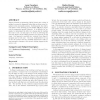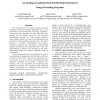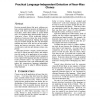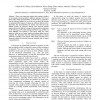848 search results - page 68 / 170 » Understanding Obfuscated Code |
FOAL
2009
ACM
14 years 3 months ago
2009
ACM
Aspect-oriented programming (AOP) fosters the coding of tangled concerns in separated units that are then woven together in the executable system. Unfortunately, the oblivious nat...
CSMR
2007
IEEE
14 years 3 months ago
2007
IEEE
As software systems evolve, they become more complex and harder to understand and maintain. Certain reverse engineering techniques attempt to reconstruct software models from sour...
WCRE
2003
IEEE
14 years 2 months ago
2003
IEEE
Our research goal is to retarget image processing programs written in sequential languages (e.g., C) to architectures with data-parallel processing capabilities. Image processing ...
CASCON
2004
13 years 10 months ago
2004
Previous research shows that most software systems contain significant amounts of duplicated, or cloned, code. Some clones are exact duplicates of each other, while others differ ...
WCRE
2010
IEEE
13 years 7 months ago
2010
IEEE
—There are numerous studies that examine whether or not cloned code is harmful to software systems. Yet, few of them study which characteristics of cloned code in particular lead...




